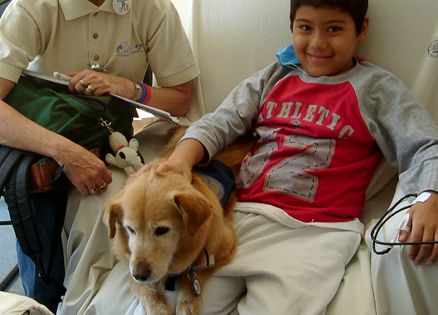In doctor’s offices, hospitals and nursing homes all over the country, a special group of caregivers are devoting their lives to helping the ill, injured and elderly. Tirelessly giving and always ready to work, these important members of the medical community have healed and cheered countless patients—offering solace, easing their pain and bringing them hope for the future. In return, they only ask for one thing: dog biscuits.
Today, animal-assisted therapy—interaction with an animal that serves as a fundamental part of a patient’s treatment—has gone from an occasional novelty to a widespread practice. In many a medical office, dogs (along with cats, horses, birds and even the occasional lizard) can be found offering companionship—whether they’re offering a much-needed social outlet, comforting those in pain or reducing stress in patients of all ages and backgrounds.
It’s a trend that’s been 50 years in the making. Animal therapy dates back to the 1940s when the very first therapy dog became one of countless inspiring stories to emerge in the aftermath of World War II. When a tiny Yorkshire terrier named ”Smoky“ visited her wounded master, Corporal William Wynne, at a military hospital in the Philippines, nurses noticed that her presence boosted the energy and lifted the spirits of the other wounded soldiers as well as the corporal. Soon, Smoky had been nicknamed “The Yorkie Doodle Dandy” and was accompanying Dr. Charles Mayo (a founder of the famous Mayo Clinic) on rounds throughout the hospital.
Since then, the impact of therapy animals has been profound, from offering companionship to the lonely among nursing home patients to real medical benefits. Patients report feeling happier and less stressed after only a half hour of contact with a therapy animal; high blood pressure drops to healthier levels; and patients in comas have even shown near-normal brain activity when an animal is present.
JoAnn Turnbull, Marketing Director of the national nonprofit organization Delta Society, explains, “Within five or ten minutes, we can see patients get healthier just from having contact with a therapy animal. People with chronic illnesses or who suffer from depression become engaged when they visit with a dog or a cat, and they’ll engage with other people through the animal. The animals are a bridge to communication.”
But while it’s easy to simply list the many benefits of animal therapy, nothing compares to the emotional impact of seeing it at work. Recently, in a classroom outside Chicago, Illinois, a shy young boy who had been badly scarred after a burn accident was given a special responsibility: caring for a therapy dog named Mattie who was visiting his school that day. As he put down a clean bowl of water and stroked the dog’s silky coat, the teacher looking on saw something incredible.
Her student, standing beside Mattie with his head held high, was laughing and talking easily with his classmates for the first time in years.






